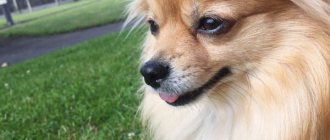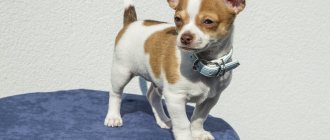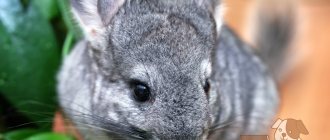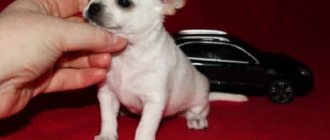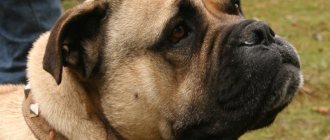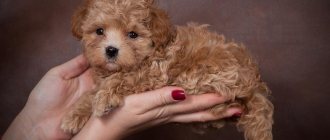Features of the Chihuahua breed, its feeding, care, health, pregnancy and vaccinations.
What colors and sizes are Chihuahua dogs? How many years do they live at home, to what age do they grow, when do Chihuahua dogs’ ears stand up, and when do their teeth change? At what age should a puppy be adopted, spayed, neutered, and what vaccinations should a Chihuahua puppy have? How many times a day and what food is best to feed a dog, how much should a Chihuahua dog eat at a time, and what weight should a Chihuahua dog weigh? How often and how many days does a Chihuahua dog's pregnancy last?
Types of Chihuahua breed
The Chihuahua dog has an unusual disposition and has been leading the list of top dog breeders for several years now. This is due to the fact that the dog is small in size, so it can easily be kept in an ordinary city apartment. In the article we will talk about the features of keeping these dogs and their development.
There are several breeds and options for dividing these dogs. Initially, all dogs are divided into two types:
- Shorthair
- Longhair
Puppy
The most interesting thing is that dogs with short hair shed much more often, since their hair is very thick and short. There is also a fur underneath, so these dogs require careful grooming and constant brushing.
Long-haired dogs look larger, however, this is an optical illusion. The large size of the peach is due to the presence of dense wool, which is very fluffy and can hang almost to the floor. It is recommended to trim these dogs.
Chihuahua breed types:
- Chihuahua cobby type. These dogs are quite strong, dense, with thick and wide bones. The dog has a large head, small ears, and big eyes. In general, a dog of this breed is quite strong, with thick hair and pronounced undercoat, and looks quite massive.
Cobby - Deer type. Translated, it means deer; indeed, the dog is a bit like a roe deer, only in a smaller form. Very thin legs and petite build. The head is small, but the ears are high and large. The coat is not very thick due to the fact that there is practically no undercoat.
Deer type
These two types of Chihuahuas are recognized by dog handlers and participate in various exhibitions. The most interesting thing is that there are other breeds that are not recognized by dog handlers, but are quite common among non-specialists.
Unrecognized Chihuahua breeds:
- Classical
- Aborigines
- English
- Pekingese
- Extreme
- Exotic
They all differ from each other in size and build. But they are not recognized by dog handlers, so you are unlikely to get into an exhibition with such a dog. Please note that only dogs that belong to the standard are also allowed for breeding.
Deer type
Who should get a Chihuahua?
Whether to choose a Chihuahua as a companion or not is up to everyone to decide for themselves. If you need a miniature friend who will accompany you everywhere and carefully watch every move of its owner, you should buy a puppy of this breed. A pet can be kept in a purse, in your arms or in a carrier for a long time without causing any inconvenience.
Chihuahuas love affection and reciprocate. They are devoted to their owner and are ready to defend him. It is worth considering that if the owner shows weakness, the dog will strive for dominance. He does not tolerate disdainful treatment of himself, especially from children.
After weighing all the pros and cons, most lovers of decorative dogs choose a Chihuahua.
Chihuahua: size and weight
Chihuahuas differ from each other in breed, and accordingly this leaves its mark on the size, as well as the weight and height of the dog. Accordingly, a Chihuahua, whose size and weight is average, ranges from 1.5 to 3 kg. And the height is from 15 to 30 cm. There are differences between dwarf, medium or large Chihuahuas. Below is a table showing the growth of puppies up to one and a half years old.
Data table
How long do Chihuahuas live at home?
The average life expectancy is 15-16 years. But there are also pets that live for more than 20 years and make their owners happy. However, unfortunately, this does not happen as often as we would like. The atmosphere inside the house, as well as the diet and maintenance of the dog, are of great importance.
Dog handlers claim that Chihuahuas live at home, are fed healthy food, receive regular vaccinations, are examined by a veterinarian, much longer, and can live up to 20 years. The number of births in girls is also of great importance. It has been established that those females who give birth quite often do not live long, up to 10 years. This is due to the fact that childbirth exhausts the dog, making him weak.
Cute dog
How to choose a puppy
The breed is considered exclusive, expensive and glamorous. To get a truly high-quality purebred puppy, you need to contact a nursery. A good breeder will definitely present all the necessary documents and tell the potential owner about the breed line, parents, and possible diseases. He will help you decide on a puppy.
First of all, you need to decide on the gender, age and class of the future pet. The character of the dog depends on the gender, and the cost depends on the age and class. You can pick up a puppy from its mother at 2-3 months ; small puppies are easier to raise, but they require more attention. At 5-6 months, pets acquire the appearance of an adult dog, but they are more expensive and more difficult to train.
The class is awarded to puppies that have already grown up, but breeders make a prediction.
- Pet class - pets for home keeping, which may have deviations from the standards.
- Breeding class – dogs with ideal conformation, suitable for breeding.
- Show class – exhibition animals with high-quality pedigree.
The puppies are very small and cute, but quite fragile. It is difficult to judge a dog's future appearance by its exterior. But they should not have obvious pathologies and deviations. The average cost is 10-60 thousand rubles .
When do Chihuahua ears stand up?
Many owners are interested in when their pets’ ears will stick out and return to their permanent position. However, there is no clear answer to this question, because such a norm is not regulated anywhere.
When a Chihuahua's ears stand up:
- It is believed that long-haired dogs' ears stand up at about 1 month of age, and long-haired dogs' ears stand up at 2 months. However, there are also individual characteristics of a dog’s development. Therefore, dog owners often resort to tricks and expose their pets’ ears on their own.
- To do this, use a toothpick or a ballpoint pen and a band-aid. To glue the ears, the shell itself is wiped on both sides with alcohol, disinfected and a kind of splint is glued in the center of the petal.
- Thus, thanks to this frame, the ears do not fall. Please note that if you are offered to purchase a puppy that is six months old and his ears are drooping, this is a serious problem.
- The fact is that this breed’s ears cannot stand up at all; this is considered a serious pathology. Such a dog will not be taken to the exhibition and will not be allowed to participate in mating. This is due to the fact that the pregnant bitch may have been poorly fed and the living conditions were not the best.
- Accordingly, she simply did not have enough nutrients to pass them on to her puppies to the required extent. Because of this, some developmental defects are observed, including the positioning of the ears in puppies.
Cuties
Disadvantages of a mini Chihuahua
Like any other breed, the Chihuahua has its advantages and disadvantages. The disadvantages of decorative dogs include:
- The fragility of the structure - the owner needs to control himself and his children so as not to accidentally injure the pet.
- They do not tolerate low air temperatures well; in cold times they need insulation (clothing and shoes).
- In a stressful situation, uncontrollable urination is possible.
- They can be stubborn, touchy and jealous.
- They love to bark.
- There may be problems with reproduction due to the small size of the Chihuahua.
When does a Chihuahua change teeth?
The first teeth of the Chihuahua breed appear at the age of 1 month. At about 2 months, the dog already has full growth of milk teeth, their number is 32 pieces.
Changing teeth in a Chihuahua:
- The replacement of baby teeth with permanent ones occurs at the age of approximately 4-7 months. By about 9 months, the dog should have all its permanent teeth, 42 in total.
- Please note that the change period can cause a lot of anxiety in the puppy, which is associated with unpleasant and painful sensations. During this time, it is necessary for dog owners to regularly monitor the condition of their pet's mouth. The fact is that gradually the roots of baby teeth dissolve, become loose and are pushed out by permanent teeth.
- However, there are also troubles when a healthy tooth is already growing, but the baby tooth has not yet fallen out. Thus, two rows are formed that can change the dog’s bite and make it incorrect.
- That is why baby teeth must be removed on time if they interfere with the growth and development of permanent teeth. Therefore, it is recommended at this age to have regular dental examinations and, if necessary, to remove all interfering milk teeth that do not allow permanent teeth to grow in time.
- During this period, it is necessary to monitor the dog’s diet so that it is under no circumstances too soft. Oddly enough, most often dental pathologies occur in dogs that are fed soft food and do not strain their chewing muscles.
- Due to this, the jaw develops poorly, and pathologies in the development of teeth can be observed. Therefore, constantly give your dog a rodent, solid, tough food, so that he tenses his chewing muscles and trains his jaws.
Cute puppy
What to feed?
Since there are two types of feeding dogs, you must first decide what you prefer to feed your pet and not deviate from the chosen path. Mixing industrial feed and natural products is strictly not recommended.
If you prefer industrial food, it is better to use premium products designed for small breeds of dogs. The amount of food depends on the age and weight of the Chihuahua. So for 1 kg of an adult dog you need 50-80 grams of dry food.
If you prefer to cook your own food, consider the advice of professionals.
- Meat . You can give veal, beef, horse meat, turkey chicken and sea fish fillet. Once a week, offer offal - heart, liver, kidneys. To avoid infection with helminths or salmonella, heat the meat. It is forbidden to feed pork, lamb, chicken skin, pollock fillet, and bones. Fish should be given 1-2 times a week.
- Vegetables . It is preferable to carry out heat treatment. Potatoes are undesirable; as an exception, offer only boiled ones in their jackets. Carrots are incredibly healthy, but to absorb vitamins you need to add 1-2 coffee spoons of vegetable oil.
- Fruits . Bananas (a source of potassium) and apples (vitamins, minerals and pectin, which removes harmful substances from the body) are considered especially useful. Be careful with fruit and don't offer it too often.
- Cereals . Cook buckwheat or rice porridge for your pet.
- Eggs . Once a week it is worth giving a boiled egg or an omelet. Make sure your baby doesn't have a protein allergy.
- Dairy . Low-fat cottage cheese, yoghurts (without fruit fillings), and kefir are recommended. Whole milk should not be given.
An adult two-kilogram dog should eat 100-150 grams per day. The amount depends on the activity of the Chihuahua. At the same time, two thirds of the products should contain protein and only 1/3 should contain plant foods. If you have chosen natural products for your pet, do not forget to periodically take a course of vitamins.
When is a Chihuahua spayed?
Not all owners get their pets in order to produce offspring or engage in a kind of business selling puppies. Many people get a dog for the soul and for their own entertainment, so all the troubles associated with estrus and sexual behavior in dogs become a real test for the owners.
Sterilization of a Chihuahua:
- Male Chihuahuas become very aggressive during the heat period, and their behavior may change. In addition, they mark the territory. Accordingly, if you are not ready to constantly wipe the puddle off the floor and look for places where your dog has urinated, it is best to have your dog spayed or neutered.
- On average, this operation is performed at the age of 6-12 months. It is best if in females it is carried out before the first heat. It is believed that in this way it is possible to almost 100% prevent the appearance of a breast tumor.
- In most cases, no specific preparation for sterilization is required, especially if the puppy is young and has no health problems. The situation is somewhat different if the dog is 5 years of age or older, then additional tests and tests may be required.
- The fact is that the cardiovascular system of such pets may not work in the best way, so you need to make sure that the dog will tolerate anesthesia without health consequences. During sterilization, the uterus and ovaries are removed in girls, and the testes and sometimes the scrotum in males.
- Recently, operations have been carried out using internal sutures, which do not require maintenance. Accordingly, this minimizes the care of the dog and its anxiety in connection with discharge from the suture area.
- After the operation, the pets are put on a blanket or collar to prevent the stitches from coming apart.
Handsome
Who is better to choose - a bitch or a dog?
Boys and girls Chihuahuas have big differences in character and physiology. Many dog breeders prefer to buy males, since females go into heat twice a year, and pregnancy and childbirth often involve complications. And although problems with hygiene and random matings can be solved quite simply, males are purchased more often. At the same time, girls are more obedient, diligent and attentive. Males are active, look presentable, and have a better chance of winning at shows. But they also have their drawbacks - they mark their territory and should not be let off the leash during walks, as they can run after the bitch.
The right to choose the gender of the future pet remains with the dog breeder and depends on the purpose of purchasing the puppy and personal preferences.
When does a Chihuahua come into heat?
Chihuahuas begin to come into heat at the age of 6-9 months. Oddly enough, owners can skip this process because the breed is very clean, so it constantly licks itself. However, in most cases, owners notice changes in behavior, as well as dark bloody discharge from the loop.
How does a Chihuahua go into heat:
- During this period, you must be very careful and walk your dog only on a leash. Otherwise, offspring are guaranteed, and not at all from the male you would like. Please note that some dogs come into heat a little later, but there is no cause for concern.
- If you are very worried, you can contact your doctor for advice. The duration of estrus is approximately 20-23 days. However, not all this time the dog will experience discharge from the genital tract.
- Most often, the period in which the dog is ready to mate occurs from 10 to 16 days. It is during this period that the egg has matured and is ready for fertilization and production of offspring. Please note that just like other dogs, Chihuahuas shed approximately 2 times a year.
- This is absolutely normal; it is believed that a dog can become pregnant twice a year. It is with this frequency that estrus is observed in doggies. To avoid a lot of inconvenience for owners, you can buy special panties for your dog that will absorb discharge.
- Try to be affectionate with the dog during this period, and under no circumstances scold him for dirtying carpets or upholstered furniture. For this period, it is best to purchase special covers and put them on the furniture so as not to get it dirty.
Advantages and disadvantages
Chihuahuas, like any other dog breed, have their pros and cons.
Advantages of the breed:
- Small size, which allows you to keep them even in a small apartment;
- The dogs are in good health and hardy;
- They have a fairly stable psyche when compared with other small breeds;
- Easily adapt to new conditions;
- They are playful and active;
- They are distinguished by their devotion to their owner and love to communicate;
- Chihuahuas have a high level of intelligence and easily understand others;
- You don’t need to walk with them for a long time, and if necessary, the dog can use a tray or diaper;
- Get along with other pets: cats, rodents, birds;
- They are wary of strangers, have sensitive hearing and bark loudly, which makes them excellent watchdogs.
Disadvantages of the breed:
- They need warmth more than any other breed. This is especially true for short-haired Chihuahuas;
- During the cold season, clothing is required for them;
- Not suitable for everyone, because they require careful and careful handling;
- They are not resistant to stress, which manifests itself in uncontrolled urination;
- They can only be walked on a leash, and they also require additional supervision on the street when other dogs are paying attention to them;
- They bark loudly;
- They are distinguished by stubbornness, jealousy and resentment;
- They can be aggressive and uncontrollable if not trained in time.
When should Chihuahua puppies get their first vaccinations?
The most interesting thing is that the first vaccinations for Chihuahua puppies are given at the age of 8-9 weeks. This breed is purchased at the age of approximately 2 months; therefore, the first vaccinations must be done by the breeder, that is, the dog’s first owner. Further, the next owner must carry out repeated vaccinations. The dog is vaccinated for the first time against leptospirosis, distemper, adenoviruses and hepatitis viruses.
Repeated vaccinations are given exactly one month later, at an average of 12 weeks, and are essentially the same as the first time. That is, they consolidate the result obtained. The second time, a rabies vaccination is added, which is not present in the first option. The next vaccination is done after a year. After this, dogs must be vaccinated annually. Please note that after purchasing a puppy, its passport must indicate that the breeder has vaccinated the puppy. Otherwise, you will have to urgently contact a veterinarian and get comprehensive vaccinations yourself.
Pregnant dog
History of the origin of the species
The homeland of miniature dogs is sunny Mexico, namely the state of Chihuahua, after which the breed was named. The exact time of appearance is unknown, approximately 4-5 century AD.
Long-haired little Techichi were found and tamed by the ancient Toltec tribes. Back then, wealthy Indians kept several dogs in their houses. There is a version that they were mute. One way or another, pets were used for religious purposes. It was believed that they carried the souls of the deceased to another world, so when the owner died, the dog was mummified and buried with him.
In 1850, an American archaeologist found figurines, mummies and rock paintings of Techichi in the temple of Montezuma (Mexico), similar in appearance to modern Chihuahuas.
A few centuries later, Mexico was filled with the Aztec and Mayan tribes. They became the new masters of Techichi. People still honored dogs and used them for religious purposes. The nightmare for the dogs was that now they were not only mummified, but also eaten.
At the beginning of the 16th century, the conquistadors conquered Mexico and the Techichi population declined sharply. Animals were killed and eaten. In addition, the Chinese Cresteds, who arrived on ships with people, mixed with Techichi, the breed changed its appearance. The smartest individuals fled to the forest, where they lived in isolation until the 19th century. Most likely due to this brutal attitude, Chihuahuas are aggressive towards strangers and children.
In the years 1870-1890, Mexicans found cute little dogs in the forest and decided to sell them. Delighted Americans bought baskets of Chikhov on the Mexican border. In 1884, the first breed exhibition was organized in Philadelphia. In 1904 the dog was entered into the American stud book, and in 1907 into the English stud book. The club opened in 1923.
Now the breed is considered national in Mexico. Puppies are given as gifts only to the most dear guests and close people. The tradition was started by the president, who gave singer Adelina Patti a bouquet of flowers with a dog in it.
What is the best food for a Chihuahua?
Undoubtedly, such dogs cannot be fed from the table. It is imperative to adhere to a strict diet:
- Porridge
- Boiled lean meat
- By-products
- Dairy
Preparing food for a dog takes time, so ready-made food is often used to save time.
List of the best food for Chihuahuas:
- NOW Natural Fresh Small Breed Recipe
- Grandorf 4 Meat & Brown Rice
- Almo Nature Holistic Adult Dog Small
- Purina Pro Plan Small & Mini Adult canine
- Bosch Mini Adult
Cute little dog
Pregnancy in a Chihuahua: symptoms
You should not expect your dog to show any symptoms of pregnancy immediately after mating. Usually the first signs can be seen no earlier than after 20-25 days. There are no tests for dogs like there are for people, so pregnancy can only be determined by a doctor, but also after 20 days. It is this period that is the turning point when it is already possible to determine and diagnose pregnancy by palpation.
Symptoms of pregnancy in Chihuahuas:
- However, pet owners may observe changes in the girl's behavior. They are usually observed starting 14 days after conception. The dog’s behavior changes, it becomes calmer and more balanced, spends little time walking outside, and immediately goes home.
- She spends most of her free time in her bed and is not as playful as before. In the period after 20 days, the dog may experience toxicosis, therefore the appetite decreases.
- Do not insist on food, and feed your dog foods high in calcium. You can give special vitamins for dogs. The longer the pregnancy, the calmer the girl becomes. She is phlegmatic and practically does not react to stimuli. Doesn't walk much, may lick private parts.
- Pregnancy can also be determined by the nipples, as they swell. After 2 months, immediately before giving birth, the dog may experience mucous discharge from the vulva. This indicates that the mucous plug is coming out and the dog is ready to give birth.
Dog after birth
Chihuahua: owner reviews
In general, these dogs are quite friendly, but they can hardly be called very calm. The fact is that such dogs love to bark, they are often called bells, due to the fact that there is practically no rest. Every time he goes outside, he barks and wags his tail.
Chihuahua, owner reviews:
Alexander . I got this dog 2 years ago, I have a male who was neutered at the age of 8 months. It does not mark territory and has a phlegmatic character. He barks a lot and is calmer at home than outside. You can safely walk without a leash, since he is not aggressive, does not rush at anyone, and after going to the toilet, asks to go home.
Alexei . They gave me a Chihuahua. As soon as I received this strange gift, I laughed, because the dog seemed very funny to me. Long, thin legs and erect ears. I thought it was not a dog, but some strange monster. But now I’m used to it, I love him very much, the dog is very smart and sensitive to any changes in the owner’s mood. I have no problems with him, I had problems with vomiting and nausea, but after contacting the veterinarian, we were prescribed treatment, and the dog’s condition returned to normal.
Evgenia . I bought myself a Chihuahua girl not for breeding purposes, but to make a friend. For health reasons, on the recommendation of a veterinarian, I mated my girl when she was one and a half years old. She brought 4 puppies, the birth was quite difficult. Two puppies were born head first, and two were born pelvic forward. I was very worried, so I called the vet. She did the right thing, because after the birth of all the puppies the placenta did not come out, so there could be rot. A week after giving birth, the dog began to feel very bad and her condition worsened. She took her to see a doctor and found out that she lacked vitamins and calcium. They prescribed injections in courses. It’s good that I went to the doctor then, my baby’s health returned to normal, now we only have two puppies, two of which we have already sold. We hope that our kids will find themselves in good hands. I recommend this breed to everyone, as it is very cheerful and friendly. In addition, it does not take up much space in the apartment, and is very clean.
This breed is ideal for residents of modern apartments. The dog requires little space and has a good disposition.
Character
Little babies are distinguished by incredible courage and bravery. They won’t even think about whether to attack a huge dog while out for a walk. This can lead to injury to the desperate pet, so owners must keep the situation under control.
Some may find Chihuahuas to be overly clingy. These dogs are incredibly attached to humans. Often, out of the whole family, they choose one person from whom they constantly demand attention. So much ingenuity in that little head! He will definitely come up with something that will turn the gaze of his beloved owner on himself.
The character of miniature dogs is very suspicious, so they perceive strangers and other dogs as potential enemies. However, these kids get along well with each other. If you want to buy your miracle a friend, feel free to buy a second Chihuahua.
Who is better to get a Chihuahua?
- Aged people . For them, the dog will become a wonderful companion who will entertain, make them laugh, and give devotion and love. With him the owner will not feel lonely.
- Families with children . Chihuahuas get along well with children, but at an immature age the child often injures the tiny pet. The Chihuahua may bite him in defense. However, for those families whose children have already reached school age and have a responsible approach to communicating with animals, this breed will only bring joy.
If your work requires you to often be away from home, you will doom your pet to loneliness, which is extremely undesirable for these animals.
